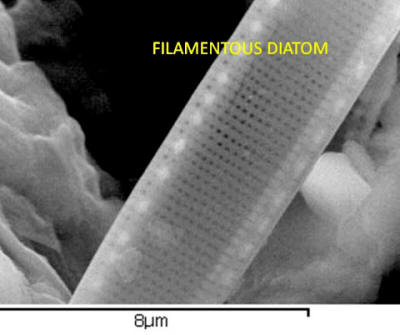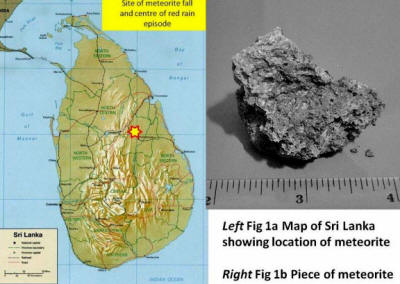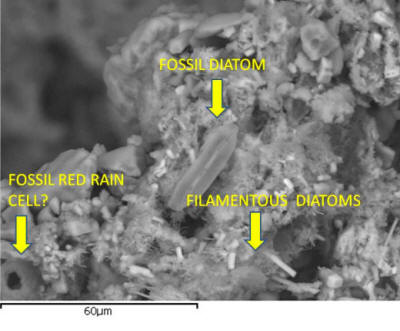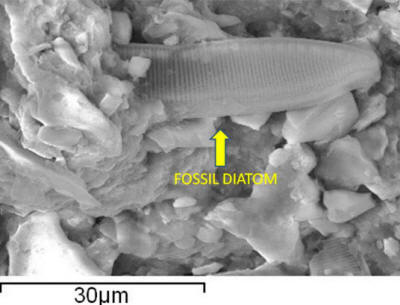|
from Examiner Website
A team of four scientists has written an article in the latest edition of the Journal of Cosmology claiming that a meteorite discovered in Sri Lanka contains evidence of extraterrestrial life.
Inside the meteorite, according to Professor Chandra Wickramasinghe, the lead scientist and Director of the Buckingham Centre for Astrobiology, are tiny fossil microbes that are extraterrestrial in origin.
The findings of Wickramasinghe and his team in their co-authored article, “Fossil Diatoms in A New Carbonaceous Meteorite", immediately aroused controversy.
In an article in the Huffington Post published on January 19, Lee Spiegal addressed the controversy and Wickramasinghe’s response to early criticism. Critics claim that the meteorite sample examined by Wickramasinghe’s team was very likely contaminated by Earth based algae.
This raises suspicion that once again scientists claiming they have found evidence for extraterrestrial life will be subjected to a firestorm of criticism including direct personal attacks from their peers.
Chandra Wickramasinghe is no stranger to controversy. The Sri Lanka born mathematician was the founder of the theory of Panspermia along with British physicist Fred Hoyle.
Panspermia is based on the idea that life is spread throughout the universe in the form of microbes carried on the back of meteorites that travel through the interstellar vacuum. Wickramasinghe believes that the Sri Lanka meteorite is vindication for his controversial theory, and has solid scientific evidence supporting his conclusions.
According to the abstract in Wickramasinghe’s and his co-author’s article:
Basically, diatoms are a form of algae that are mainly unicellar and form large colonies.
They are a major producer in the food chain. Finding fossil diatoms in a meteorite is hard evidence that extraterrestrial life not only exists, but is commonly found throughout the galaxy.
Not so according to Phil Plait, who launched a preemptive strike before the major media and public had a chance to digest Chandrasinghe’s findings.
Plait’s column in Slate magazine begins with a very unscientific ad hominem attack since he writes in the article that “sometimes an ad hominem is warranted!”
According to Plait:
Plait finally launches into the main substantive criticism he has to offer which comes from an evolutionary biologist who responded to Plait’s request to analyze Wickramasinghe’s article.
Professor Patrick Kociolek from the University of Colorado wrote back to Plait:
Essentially, Kociolek and Plait are claiming that Wickramasinghe’s data was compromised by fresh water on Earth.
The Huffington Post contacted Wickramasinghe and invited him to respond to Plait’s criticism.
Regarding Plait’s and Kociolek’s main argument that the meteorite sample was contaminated by earth water algae or diatoms, Wickramasinghe continued:
This is where Plait’s and Kociolek’s criticism falls short since they can’t explain the origin of all the diatoms found in the meteorite.
This is not the first time that scientists finding evidence of extraterrestrial life in meteorites have been exposed to the criticism that their sample was contaminated by earth based microbial life.
In August 1996, David McKay and a team of NASA scientists published their analysis of a Martian meteorite discovered in Antarctica. The meteorite was found to have carbon compounds that looked very much like fossil remains of ancient Martian microbes.
Here is how Mackay explained their findings:
The announcement was big news at the time, and led to President Clinton making a statement contemplating the historical significance of the discovery.
The 1996 discovery then got bogged down in scientific debate over whether or not the meteorite was polluted by Earth microbes. Critics claimed NASA scientists had not sufficiently accounted for this possibility.
Not so according to a new 2009 study by NASA scientists, including McKay, from the Johnson Space Center that upheld the earlier findings and concluded:
Wickramasinghe and his team have just begun the effort of defending their results from criticisms that their meteorite sample was contaminated, and their data therefore inconclusive.
Given that controversy still swirls around the 1996 Mars meteorite case, we can expect the same for Wickramasinghe and his team’s claim of finding evidence of extraterrestrial fossils on a meteorite.
It may be some time before scientists are willing to concede that Wickramasinghe may have just verified his theory of panspermia.
Credit: Chanda
Wickramasinghe, et al.
Credit: Chanda
Wickramasinghe, et al.
Credit: Chanda
Wickramasinghe, et al.
Credit: Chanda Wickramasinghe, et al.
|




